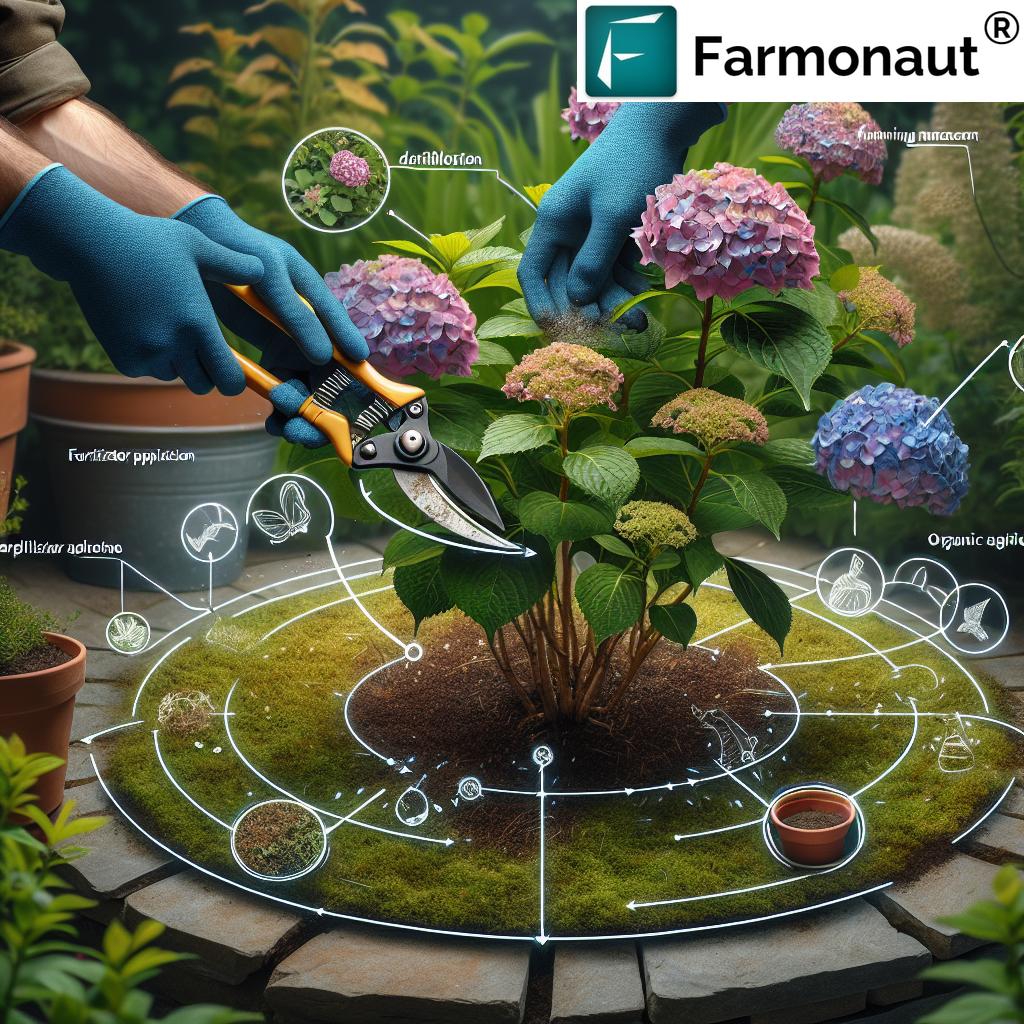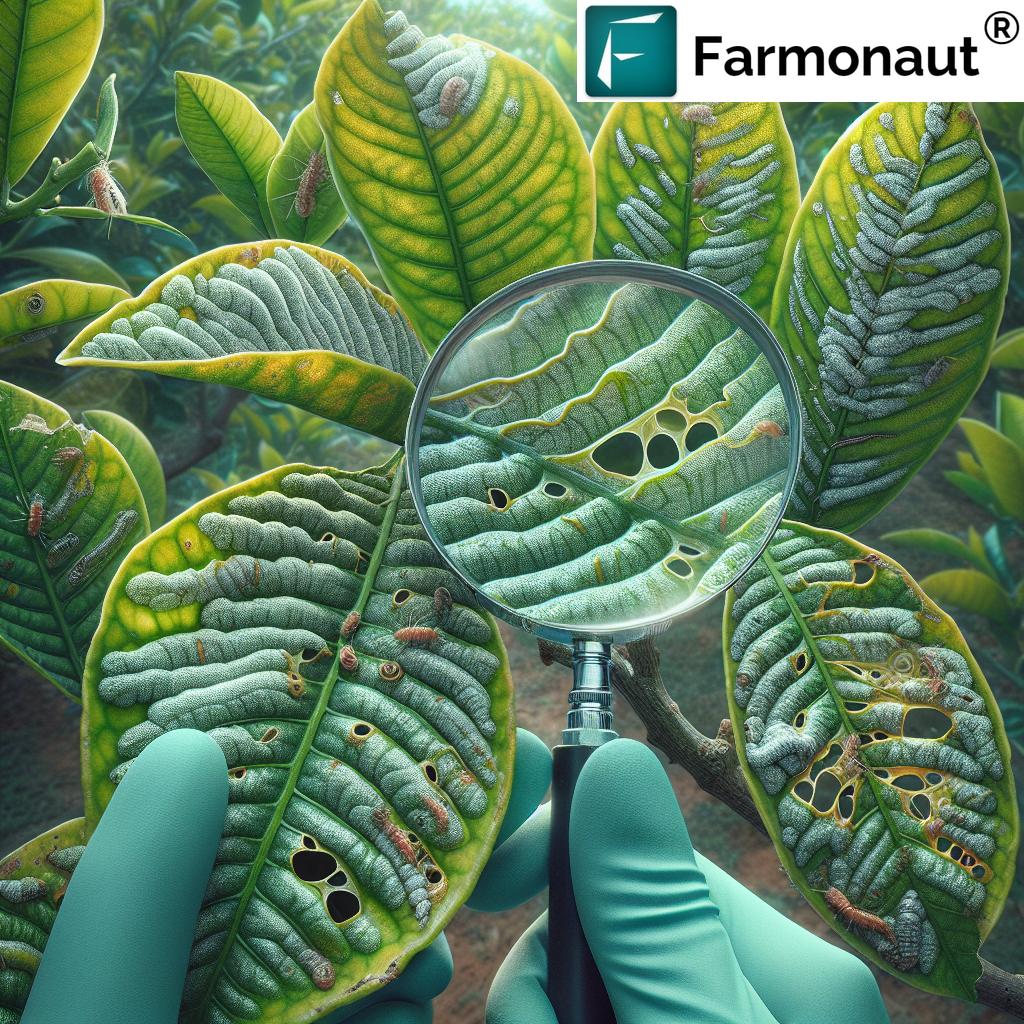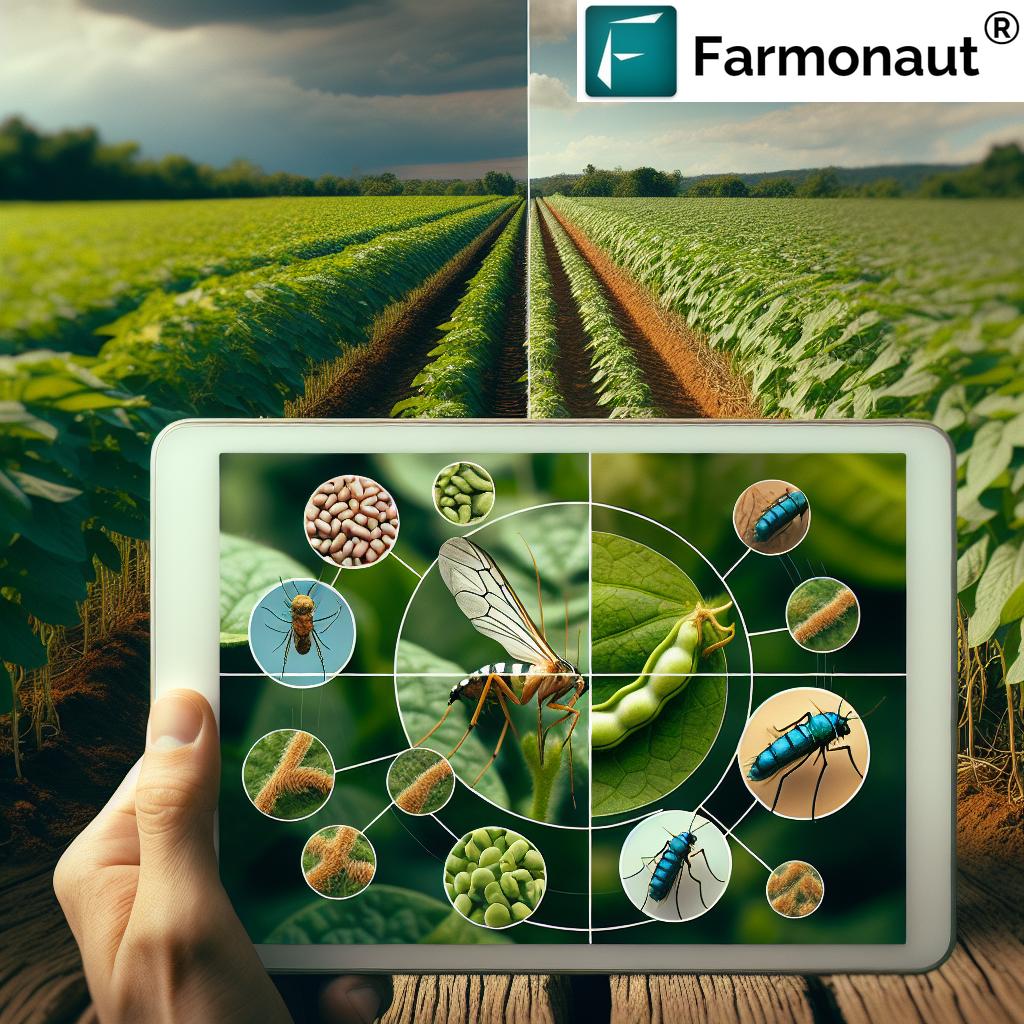Hydrangea Care Guide: 10 Essential Steps for Thriving Blooms
Table of Contents
- Introduction: Hydrangea Care Essentials
- Hydrangea Water & Pruning Trivia
- Step-by-Step Hydrangea Care Overview Table
- Planting Hydrangeas
- Watering Practices for Hydrangeas
- Best Soil for Hydrangeas and Fertilizer Application
- Hydrangea Pruning Techniques
- Organic Mulch for Hydrangeas & Soil Management
- Hydrangea Pest and Disease Management
- Changing Hydrangea Flower Color
- Winter Care and Protection
- Propagating Hydrangeas from Cuttings and Layering
- Farmonaut Tools for Agriculture, Farming, and Forestry
- Hydrangea Water & Pruning Trivia (Mid-Article)
- FAQ – Hydrangea Care
- Conclusion
Introduction: Hydrangea Care Essentials
Hydrangeas have long enchanted gardeners, farmers, and landscapers with their breathtaking, vibrant blooms and exceptional adaptability. Whether blanketing a suburban border, enhancing a woodland edge, or scaling up for agriculture and forestry projects, hydrangeas reward diligent care with abundant color and healthy growth. For cultivators seeking thriving plants, a thorough approach—from selecting the right soil to understanding seasonal pruning techniques—is key to unlocking their full potential.
In this detailed hydrangea care guide, we’ll explore step-by-step practices for planting, watering, amending soil and managing pH, fertilizer application, pest management, winterizing, and propagation. Whether you’re an individual grower, part of a larger agricultural enterprise, or involved in urban landscaping, mastering these ten essential steps will ensure your hydrangeas flourish for years to come.
“Hydrangeas need about 1 inch of water per week for optimal growth and vibrant blooms.”
Step-by-Step Hydrangea Care Overview Table
| Step Number | Care Activity | Description | Frequency/Timing | Quantitative Data | Pro Tips |
|---|---|---|---|---|---|
| 1 | Planting | Choose a site with morning sun, afternoon shade; amend soil with compost, maintain planting depth | Once, at start of cultivation | Hole: 2x width of root ball, same depth | Avoid windy spots; water thoroughly post-planting |
| 2 | Watering | Provide consistent moisture by deep watering | Weekly (increase in dry spells) | ~2.5cm (~1 inch) per week | Morning watering reduces disease risk |
| 3 | Soil Testing & Management | Test and amend soil for structure, ph, organic matter | Annually, before planting | pH: 5.5–7.0; Add 2-3″ compost | Monitor ph to control bloom color |
| 4 | Fertilizer Application | Apply balanced, slow-release fertilizer in early spring | Spring & post-flowering | 1 cup/month (per mature plant) | Avoid high-nitrogen blends |
| 5 | Pruning | Species-specific prune to remove dead wood & promote growth | Annually; timing depends on type | Prune back 1/3 oldest stems | Use sanitized tools to reduce disease risk |
| 6 | Mulching | Apply organic mulch for hydrangeas to conserve moisture, control weeds | Spring; renew each year | 2-3 inch layer, keep 3″ from stem | Pine bark & needles boost acidity |
| 7 | Pest & Disease Management | Monitor for common hydrangea pest and fungal issues | Ongoing; inspect bi-weekly | Use insecticidal soap/fungicide as needed | Increase air flow to deter fungi |
| 8 | Flower Color Management | Adjust soil pH for desired flower color | Annually, check each season | pH <7= Blue; pH >7= Pink | Change pH gradually; test often |
| 9 | Winter Protection | Insulate roots, protect buds from wind & freeze | Late autumn | Mulch: 4-6 inch layer | Burlap shields against harsh winds |
| 10 | Propagation | Use cuttings or layering methods for new plants | Spring or early summer | 6-8 in. cutting, hormone dip | Root in moist, shaded area |
1. Planting Hydrangeas: How to Plant Hydrangeas for Best Growth
If you want to kick off your hydrangea cultivation with success, start by focusing on site selection, soil structure, and correct depth. Hydrangeas thrive best when planted where they receive morning sun and afternoon shade. This lowers the risk of stress and wilting during hot afternoons, especially in temperate or warm climates. If you’re in a cooler region, hydrangeas can tolerate more sun, which actually improves flower yield.
- Choose a location with well-draining soil to avoid waterlogging and root rot.
- Amend the soil before planting with compost or aged manure to boost organic content and fertility.
- Use a spade to dig a hole that is twice as wide, but only as deep as the root ball. This ensures the plant sits at the correct depth—level with the soil in the pot.
- Remove the hydrangea gently, loosen the roots, and set in the hole.
Backfill halfway, water deeply to eliminate air pockets, and finish with the rest of the soil. Firm the surface and water thoroughly once more.
Newly planted hydrangeas require diligent watering during their first growing season to promote robust root development.
For agricultural projects, using real-time precision crop management tools from Farmonaut can help monitor soil moisture, structure, and environmental conditions, ensuring your plantations get the ideal start.
2. Watering Practices for Hydrangeas
Proper watering is one of the most crucial aspects of hydrangea care. Without consistent moisture, even the most robust hydrangea won’t achieve optimal growth or flowering. Hydrangeas generally require about one inch of water per week. This demand increases during dry weather or when plants are newly established.
- Deep watering—done 2-3 times a week—encourages strong root development and healthier plants compared to daily light sprinkling.
- Always water in the early morning. This gives the plant a chance to absorb moisture before the sun intensifies, and leaves time for surface moisture to dry—reducing the risk of disease.
- In larger farming or forestry projects, consider utilizing drip irrigation or soaker hoses to maintain consistent moisture at the root zone with minimal waste.
Too much water can cause root rot and stunted growth, while drought triggers wilting, reduced flowering, and stress—especially during the crucial summer period.
Using Farmonaut’s real-time soil moisture tracking (available via the app and API: Farmonaut Soil & Satellite API) provides cultivators with actionable alerts to optimize watering schedules and avoid both over- and under-watering, thereby maximizing bloom potential and plant vitality.
3. Best Soil for Hydrangeas and Fertilizer for Hydrangeas
Healthy, thriving hydrangeas owe much to the quality and composition of the soil.
To provide the best soil for hydrangeas:
- Test ph to ensure a slightly acidic to neutral range (pH 5.5–7.0). This is essential for nutrient absorption and both blue and pink blooms.
- Mix organic materials such as well-rotted compost, shredded leaf mulch, or aged manure before planting and as a side-dress each spring.
- Enhance drainage for clay soils by adding sand or perlite, or select raised beds.
Fertilizer for hydrangeas should be applied at the right time and in appropriate amounts:
- Use a balanced, slow-release granular fertilizer in early spring as soon as new growth appears. Avoid overly nitrogen-rich options, which can spur leafy growth at the expense of flowers.
- Typical application rates: 1 cup of granular fertilizer per established plant per month in the growing season.
- After flowering, a light feeding supports continued vigor into autumn.
For commercial cultivation or resource optimization across large tracts, Farmonaut’s satellite-based fertilizer advisory helps schedule applications and monitor soil fertility levels, improving input efficiency and sustainability.
Discover more about enhancing farm operations with Farmonaut’s large-scale farm management platform.
4. Hydrangea Pruning Techniques: Timing and Species Considerations
Effective pruning is pivotal for managing growth, stimulating flowering, and maintaining a pleasing structure. However, hydrangea pruning techniques must be matched to the species type:
• Bigleaf Hydrangea (Hydrangea macrophylla)
- Prune after blooming (late summer/early fall) because they flower on old wood.
- Remove spent blooms, dead wood, and oldest stems at ground level to promote strong new growth and larger future blooms.
• Oakleaf Hydrangea (H. quercifolia) & Panicle Hydrangea (H. paniculata)
- Prune in late winter or very early spring before new growth emerges.
- Remove dead and crossing branches, then thin out weak or crowded shoots to maintain structure.
• Smooth Hydrangea (H. arborescens)
- Heavy pruning is beneficial—cut back all stems to about 6–12 inches from the ground in late winter or early spring to encourage vigorous growth and bigger blooms, a practice particularly suitable for forestry and agricultural hedgerows.
Don’t forget to use sanitized pruning tools to minimize disease introduction.
Annual pruning—matched to your species—dramatically boosts bloom production and ensures manageable plant size. For large-scale farming or forestry applications, proper scheduling informed by AI tools like Farmonaut’s Jeevn AI Advisory System can optimize labor and maximize decorative value.
“Pruning hydrangeas annually can increase flower production by up to 30% each season.”
5. Organic Mulch for Hydrangeas & Soil Management
Mulching is a foundation of sound hydrangea care, especially for those managing larger landscapes or seeking to water less often. Organic mulch for hydrangeas provides these benefits:
- Retains moisture in the soil, reducing drought stress and stabilizing temperatures for strong root development.
- Suppresses weed competition and gradually boosts organic matter content as it breaks down, improving soil structure over time.
- In the context of agriculture and forestry, mulch minimizes erosion, especially on slopes or banks.
Effective mulching materials include:
- Pine bark or pine needles (ideal for acid-loving hydrangea varieties and enhancing blue blooms).
- Chopped leaves, straw, or high-quality compost for all-around performance.
Apply a 2–3 inch layer around the plants each spring, but maintain a mulch-free area around the main stems (2–3 inches) to prevent crown rot and disease. For skilled farm management, satellite oversight (like that offered by Farmonaut) can help monitor ground cover persistence and organic material decomposition rates to maintain ongoing health.
6. Hydrangea Pest and Disease Management
While hydrangeas are generally sturdy, they remain susceptible to certain pest and disease issues. Effectual hydrangea pest and disease management means regular inspection and prompt intervention:
- Aphids & Spider Mites: Look for sticky residue, distorted leaves, and tiny insects. Treat infestations with insecticidal soap or horticultural oils, applied early in the day.
- Powdery Mildew: Appears as white, powdery coating on leaves—typically under humid conditions and limited airflow. Improve spacing and air circulation; if needed, apply fungicides and remove infected foliage.
- Slugs: Leave ragged holes in leaves. Counter with diatomaceous earth sprinkled at the base or copper tape barriers.
- Other Issues: Watch for leaf spots, stem rot, and root rot in wet soils—good drainage remains critical.
Proactive monitoring—aided by remote sensing or in-person scouting—catches problems early and prevents disease from spreading. For commercial growers, Farmonaut’s AI-based pest and disease warning systems provide timely, actionable alerts that can reduce chemical use and improve yields. Learn more about product traceability tools to ensure your crops meet market safety standards and inspire consumer confidence.
7. Changing Hydrangea Flower Color by Managing pH in Soil
One of the most fascinating aspects of hydrangea cultivation is the ability to manipulate bloom color in certain species (notably Hydrangea macrophylla and H. serrata) by adjusting soil pH. The secret lies in the availability of aluminum ions in the soil—accessible only at specific pH levels:
- Blue blooms: Develop in more acidic soils (pH less than 7). Achieve this by applying garden sulfur, pine needles, or aluminum sulfate to lower pH and increase aluminum uptake.
- Pink blooms: Occur in more alkaline soils (pH above 7). Raise soil pH by working in agricultural lime or dolomite.
- Always test the soil before and during amendments; excessive or rapid changes can stress or damage plants.
Use a reliable soil pH tester each spring and autumn. Adjust amendments gradually and monitor plant response—flowers may take one full season to change color.
For consistent results, Farmonaut’s soil monitoring solutions are invaluable, enabling you to track pH and soil chemistry across large-scale projects and achieve the desired ornamental impact or meet landscape contracts.
8. Winter Care and Protection
Hydrangeas, particularly in colder areas, benefit greatly from thoughtful winter preparations, which ensure that buds and roots survive severe weather and bounce back vigorously in spring.
- Apply a thick (4–6 inch) layer of loose organic mulch, such as straw, bark, or compost, around the base in late autumn. This insulates roots against freezing and sudden temperature swings.
- For species with tender flower buds (like bigleaf hydrangeas), wrap plants loosely in burlap or build windbreaks for additional air circulation and frost protection.
- Do not heavily prune hydrangeas in late autumn, as this removes next year’s flower buds.
Urban and rural growers alike can use Farmonaut’s crop risk tools to track winter kill, monitor plant health status via satellite, and document crop status for insurance claims and reporting.
9. Propagating Hydrangeas from Cuttings and Layering Methods
Expanding your hydrangea stand or scaling up commercial production is easily achieved through vegetative propagation, primarily using cuttings and layering methods:
• Propagating Hydrangeas from Cuttings
- Take healthy, softwood (non-flowering) cuttings 6–8 inches long in late spring to early summer.
- Remove lower leaves, dip the lower end in rooting hormone powder, and place in a sandy, well-drained soil mix or starter pots.
- Keep the cuttings in a shaded, humid environment. Maintain consistent moisture (but avoid waterlogging) until firm roots form, generally in 3–4 weeks.
• Layering
- In spring or autumn, bend a healthy, low-growing stem to the ground. Gently wound or remove 1–2 inches of bark on the underside where it will contact soil.
- Bury this section in a shallow trench, pin in place, and cover with soil and mulch. Keep moist.
- Roots will develop by autumn. Sever from the parent plant and replant as needed.
This is an accessible option for agricultural expansion without purchasing additional stock. Supervising root development and planting conditions across a large field is streamlined with Farmonaut’s satellite imagery platform, which provides growers with scalable monitoring and resource management tools—ideal for optimizing plantation logistics.
Farmonaut Tools for Agriculture, Farming, and Forestry
When tackling hydrangea care at any scale—from specimen landscaping to extensive forestry hedges or innovative agricultural plantations—timely data enables better management, higher growth rates, and optimized resource use. That’s where we, at Farmonaut, deliver significant value:
- Satellite-Based Crop Health Monitoring: Assess soil moisture, track vegetation health, and forecast plant development cycles for hydrangeas (and all your crops) with precision insights.
- AI-Driven Management: Personalized advice via the Jeevn AI Advisory System informs water, fertilizer, and pest management schedules, maximizing soil structure, growth, and resilience.
- Blockchain-Based Traceability: Keep a verifiable record from planting to harvesting and marketing, enabling transparency and authenticity for both domestic and export markets.
- Fleet & Resource Management: Streamline machinery and labor across large plantations, tracking operational efficiency and resource allocation for optimal plant development.
- Carbon Footprinting: Track your environmental impact as you scale up hydrangea or mixed-crop operations; support sustainability certification and compliance.
All of these tools are accessible via Android, iOS, and web apps, as well as robust API integration for developers:
API Developer Docs.
Take your hydrangea cultivation to the next level—try Farmonaut’s advanced farm management solutions.
FAQ – Hydrangea Care
- Q: How much sunlight do hydrangeas need?
A: Most hydrangeas thrive in sites with morning sun and afternoon shade. In cooler climates, they tolerate more direct sun. Too much afternoon exposure can result in stress and wilted leaves. - Q: What is the best soil for hydrangeas?
A: Hydrangeas prefer moist, well-draining soil rich in organic matter, with a pH between 5.5 and 7.0. - Q: How often should I water hydrangeas?
A: Aim for 1 inch (~2.5 cm) of water per week, increasing during hot or dry periods. Deep, infrequent watering is preferable. - Q: Which hydrangeas should be pruned in the spring or fall?
A: Bigleaf types (H. macrophylla) should be pruned after flowering in late summer. Oakleaf (H. quercifolia) and panicle (H. paniculata) types are pruned in late winter or early spring. - Q: How do I change the color of hydrangea flowers?
A: Adjust the soil’s pH—lower the pH (add sulfur or aluminum sulfate) for blue, or raise it (add lime) for pink blooms. - Q: What is the best mulch for hydrangeas?
A: Organic mulch (pine bark, compost, leaves, pine needles) conserves moisture and improves soil structure. - Q: What pests affect hydrangeas, and how can I control them?
A: Common pests include aphids, spider mites, and slugs; issues can be controlled with insecticidal soap, neem oil, or physical barriers. - Q: What’s the best way to propagate hydrangeas?
A: Hydrangeas are easily propagated by 6–8-in. softwood cuttings in spring/summer, or by layering a healthy stem. - Q: How should I protect hydrangeas in winter?
A: Apply a thick mulch layer around the roots and, for sensitive types, provide wind protection with burlap wraps. - Q: Can Farmonaut help automate and improve large-scale hydrangea cultivation?
A: Yes, Farmonaut’s tools aid with real-time crop monitoring, AI-based advice on irrigation, resource management, and more—ideal for scaling hydrangea operations efficiently and sustainably.
Conclusion: Achieve Thriving Hydrangeas with Stepwise Care and Modern Tools
Hydrangeas are among the most rewarding plants for gardeners, landscapers, and professional cultivators alike, providing lush foliage, rich blooms, and even pollinator value. By focusing on these ten essential hydrangea care steps—from smart planting, attentive watering, soil structure and ph management, targeted fertilizer application, seasonal pruning, and well-timed mulching, to integrated pest management, flower color customization, effective winter care, and reliable propagation methods—you ensure long-term growth and success.
For agriculture, farming, and forestry endeavors, leveraging technology and structured management is a clear competitive edge. Farmonaut’s farm management solutions, AI and satellite-based advisories, and traceability systems provide actionable insights and unmatched scalability. Cultivate hydrangeas with confidence—combine these rigorous traditional practices with modern tech to truly thrive.


















